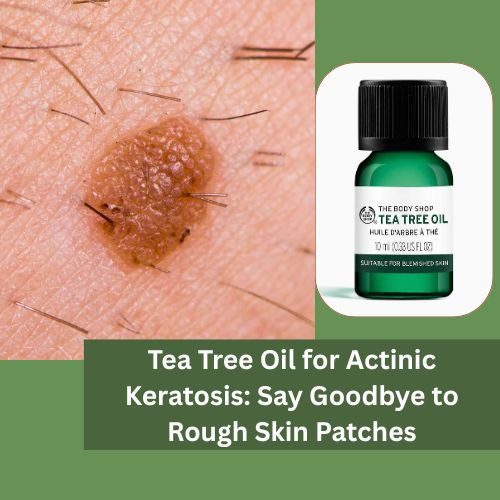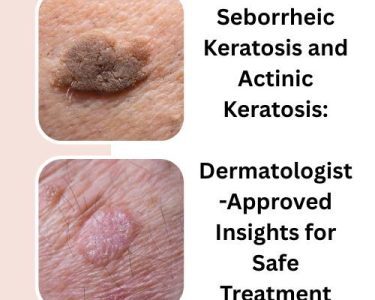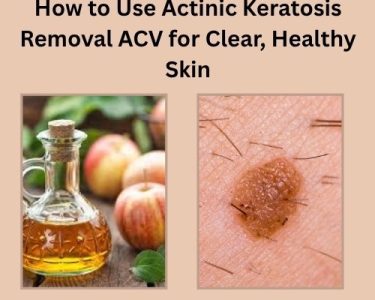Actinic keratosis (AK) is one of the most common precancerous skin conditions, often caused by years of sun exposure. It appears as rough, scaly patches on areas frequently exposed to sunlight — such as the face, scalp, hands, or arms. While medical treatments are effective, many people are turning to Natural Remedies for Actinic Keratosis for gentle, supportive care.
One such remedy that’s gaining attention is tea tree oil for actinic keratosis.
This natural essential oil, derived from the Australian Melaleuca alternifolia tree, is celebrated for its antibacterial, antiviral, and anti-inflammatory properties. But can it really help soothe and clear rough patches caused by actinic keratosis? Let’s explore how tea tree oil works, what science says, and how you can use it safely as part of your skin-healing routine.
What Is Actinic Keratosis?
Before exploring how tea tree oil can help, it’s important to understand what actinic keratosis is.
Actinic keratosis is a rough, dry, or scaly patch of skin that develops from prolonged exposure to ultraviolet (UV) radiation — either from the sun or tanning beds. These patches are considered precancerous, meaning they have the potential to turn into squamous cell carcinoma (a form of skin cancer) if left untreated.
Common symptoms include:
- Rough or crusty patches on the skin
- Red, brown, or pink discoloration
- Itching or burning sensation
- Sensitivity when touched
- Dry, sandpaper-like texture
The condition often affects people over 40, especially those with fair skin who spend a lot of time outdoors.
While dermatologists typically treat AK with cryotherapy, topical medications, or photodynamic therapy, natural options like tea tree oil for actinic keratosis are being explored for their soothing and skin-renewing benefits.
Understanding Tea Tree Oil: Nature’s Skin Healer
Tea tree oil is an essential oil extracted from the leaves of the Melaleuca alternifolia plant, native to Australia. Aboriginal tribes have used it for centuries to treat wounds, infections, and skin irritations.
Modern science supports many of its benefits, showing it has:
- Antibacterial properties – kills harmful bacteria and prevents infection.
- Antifungal properties – useful against fungal skin growth.
- Anti-inflammatory effects – reduces redness, swelling, and irritation.
- Antioxidant power – helps fight free radicals and sun damage.
These qualities make tea tree oil for actinic keratosis a potentially helpful natural remedy. While it may not cure AK, it can support healing, minimize inflammation, and promote clearer, healthier-looking skin.
How Tea Tree Oil Helps with Actinic Keratosis
1. Anti-inflammatory Action
Actinic keratosis often involves inflammation due to sun damage. Tea tree oil contains terpinen-4-ol, a compound known for its strong anti-inflammatory effects. Applying diluted tea tree oil may help calm irritation, reduce redness, and ease discomfort in affected areas.
2. Antioxidant Protection
UV rays generate free radicals that damage skin cells and accelerate aging. Over time, this leads to the formation of actinic keratosis. Tea tree oil’s antioxidant compounds help neutralize free radicals, protecting your skin from further damage and supporting the regeneration of healthy cells.
3. Antimicrobial Defense
Since AK patches can become irritated or infected when scratched, tea tree oil’s antibacterial and antifungal properties act as a natural shield. It prevents secondary infections, helping your skin stay clean and protected during healing.
4. Cellular Renewal Support
Some studies suggest that tea tree oil may help stimulate skin regeneration, supporting the shedding of rough patches and the growth of new, smoother skin. This makes it an appealing natural aid in managing the rough, scaly texture of actinic keratosis.
Scientific Studies on Tea Tree Oil and Skin Lesions
While research on tea tree oil for actinic keratosis specifically is limited, several studies highlight its potential for managing precancerous and cancerous skin lesions.
- A 2012 study published in the Cancer Chemotherapy and Pharmacology found that tea tree oil and its component terpinen-4-ol induced apoptosis (programmed cell death) in certain cancer cell lines without harming normal cells.
- Another study in BMC Cancer reported that topical tea tree oil slowed tumor growth in animal models of skin cancer.
- Although these studies are preliminary, they suggest that tea tree oil might help manage abnormal skin cell growth when used carefully and under guidance.
It’s important to note that tea tree oil should never replace medical treatment for actinic keratosis but can be used as a complementary remedy to support skin health.
How to Use Tea Tree Oil for Actinic Keratosis
Because tea tree oil is highly concentrated, it must be diluted before application to avoid irritation or burns. Follow these safe and effective methods to incorporate tea tree oil into your skincare routine.
1. Direct Application (Diluted)
Ingredients:
- 1–2 drops of tea tree oil
- 1 teaspoon of carrier oil (such as coconut, olive, or jojoba oil)
Method:
- Mix tea tree oil with the carrier oil.
- Apply gently to the affected skin patch using a cotton swab.
- Leave it on for 20–30 minutes, then rinse with lukewarm water.
- Repeat once or twice daily.
This method helps soothe rough patches and minimize redness over time.
2. Tea Tree Oil and Aloe Vera Gel
Ingredients:
- 1 teaspoon aloe vera gel
- 2–3 drops of tea tree oil
Method:
- Mix well and apply to affected areas.
- Leave it overnight if your skin tolerates it.
- Wash your face the next morning with mild cleanser.
Aloe vera hydrates and cools the skin, while tea tree oil fights inflammation and infection.
3. Tea Tree Oil Compress
If your AK patches cover a larger area (like the scalp or hands), a compress works well.
Method:
- Add 4–5 drops of tea tree oil to one cup of warm water.
- Soak a clean cloth in the mixture.
- Apply the cloth to the affected area for 10–15 minutes.
- Repeat daily for visible improvement.
4. Tea Tree Oil in Skincare Cream
You can also add tea tree oil to your moisturizer or use a ready-made tea tree-based cream for gentle daily application. This helps maintain your skin’s moisture while keeping inflammation under control.
Precautions and Safety Tips
While tea tree oil offers natural benefits, using it incorrectly can cause side effects. Always follow these safety guidelines:
- Never use undiluted tea tree oil. It can cause irritation, redness, or burns.
- Do a patch test first. Apply diluted oil to a small area of skin and wait 24 hours to check for reactions.
- Avoid contact with eyes, mouth, and open wounds.
- Pregnant or breastfeeding women should consult a doctor before use.
- If irritation, swelling, or itching occurs, discontinue use immediately.
- Consult your dermatologist before using tea tree oil for actinic keratosis, especially if you’re undergoing medical treatments like cryotherapy or photodynamic therapy.
Other Natural Remedies to Complement Tea Tree Oil
If you’re exploring holistic ways to manage actinic keratosis, consider combining tea tree oil for actinic keratosis with other natural remedies for added benefit. This approach can be part of an effective Actinic Keratosis Natural Treatment plan that supports healing and helps protect your skin from further sun damage.
1. Apple Cider Vinegar (ACV)
ACV has mild acidic properties that can help exfoliate dead skin and smooth rough patches. When used properly, it supports tea tree oil’s cleansing action.
2. Green Tea Extract
Green tea contains polyphenols that protect skin cells from UV damage and may help slow the progression of AK.
3. Coconut Oil
Coconut oil nourishes and moisturizes the skin, making it an ideal carrier for tea tree oil while soothing dryness and irritation.
4. Vitamin E Oil
A potent antioxidant, Vitamin E supports cell repair and rejuvenation, helping reduce scarring and discoloration from sun damage.
Diet and Lifestyle Tips for Healthier Skin
Using tea tree oil for actinic keratosis works best when paired with a skin-supportive lifestyle. Try these tips for stronger, more resilient skin:
- Protect your skin from UV rays – Always wear sunscreen with SPF 50+ when outdoors.
- Wear protective clothing – Hats, sunglasses, and long sleeves help prevent new lesions.
- Eat antioxidant-rich foods – Include fruits, vegetables, green tea, and nuts in your diet.
- Stay hydrated – Water flushes toxins and supports healthy skin repair.
- Avoid tanning beds – They emit harmful UV rays that worsen actinic keratosis.
- Avoid smoking and alcohol – These accelerate oxidative stress and skin aging.
Expected Results: What to Realistically Expect
Tea tree oil works gradually. You may start noticing smoother, less irritated skin within a few weeks, depending on the severity of your AK patches and consistency of use.
However, it’s essential to maintain realistic expectations — tea tree oil can soothe and support healing but won’t remove precancerous lesions completely. Regular check-ups with your dermatologist remain crucial for monitoring changes and preventing complications.
When to See a Doctor
Even if you use tea tree oil for actinic keratosis regularly, professional monitoring is necessary. Contact your dermatologist if:
- A patch becomes painful, inflamed, or starts bleeding
- The lesion changes color or grows rapidly
- You notice new rough patches appearing
These may indicate that the lesion is progressing toward skin cancer, which requires prompt treatment.
Final Thoughts
Using tea tree oil for actinic keratosis offers a natural, gentle way to soothe irritated skin, reduce inflammation, and support healing. Its antimicrobial and antioxidant properties make it a valuable addition to your skincare routine — especially when paired with a healthy lifestyle and proper sun protection.
However, tea tree oil should be viewed as a supportive remedy, not a substitute for professional medical care. If you have multiple or stubborn lesions, it’s important to seek dermatologist advice to ensure early and effective treatment.
By combining the wisdom of nature with modern skin health practices, you can say goodbye to rough skin patches and hello to smoother, healthier, and more radiant skin.




